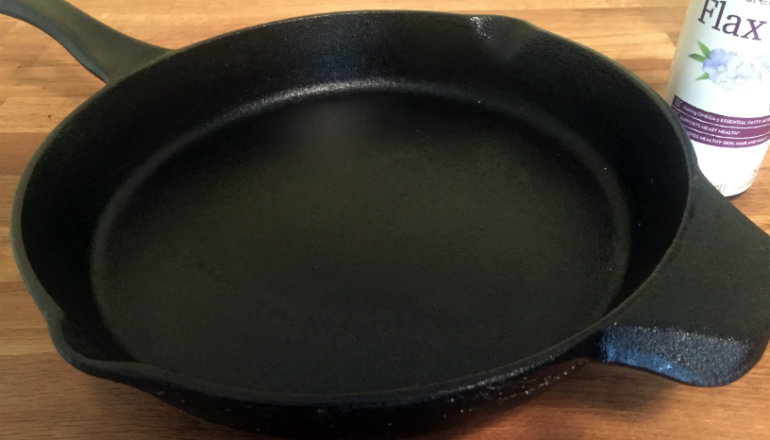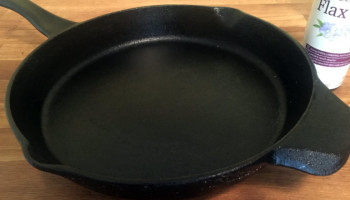 Reading Time: 3 minutes
Reading Time: 3 minutesAt 35, I have just enough wisdom to understand why cast iron is an excellent choice for cookware. It lasts a lifetime, it’s infinitely reclaimable from rust, and it is masculine in a way that no silicon-coated non-stick egg pan could ever be. Plus, it’s heavy enough to use as a doorstop (or as the counterweight to a fifty-story elevator).
Still, I lack the patience to spend days seasoning cast iron, running through eighteen hours of oiling, rubbing, baking, and cooling. The only interminable odyssey I’m willing to tolerate at this point is watching Grey’s Anatomy with my wife, and so I looked for an alternate route.
Accordingly, I took the best cast iron information I could find (via a set of hyperlinks from Mr. Winslow Jenkins, a hunter/trapper/gluten-free beer brewer/off-grid badass), added a bit of Winslow’s knowledge as a cast-iron only cook, and conducted this recipe.
It worked flawlessly.
Step 1: Prepare the Pan for Seasoning
After being grossly mistreated, my twelve-inch cast iron skillet was rusty. I grabbed some gloves, a mask, and a handful of extra fine steel wool from the garage and went to work.
After about half an hour of polishing, I’d removed the rust from the entire pan, leaving a dull, matte gray surface. This surface is your ideal starting point, and a step you should take even in the absence of rust.
Polishing finished, I cleaned the pan thoroughly with soap and water, and dried it with a paper towel.
Step 2: Use the Right Oil
Seasoning cast iron is the process of baking on a layer of oxidized fat, forming a smooth polymer surface. Toward this end, your oil choice should be very specific and your heat should be very high. After checking out this (hyper-nerdy and helpful) blog post from Sheryl Canter, as well as seeing an endorsement of her technique from Cook’s Illustrated, three things were obvious:
- Flaxseed oil is the way to go
- My oven was going to be spending some time at 500 degrees
- If it was up to these guys, I’d spend the next eighteen hours baking my skillet
Step 3: Dejected, Pick up on Winslow’s Aside
During my research phase (wherein I bugged Winslow and his wife for information), Winslow mentioned that Sheryl Canter’s technique worked great, but could be done faster.
His recommendation — oil the skillet, and bake at 500 degrees on repeat, just as she says, but instead of running six three-hour cycles, run each cycle for only ten minutes and ignore the cooling phase (and be sure not to burn yourself).
Here’s are the specifics:
- Line the bottom rack of your oven with aluminum foil to catch any stray flaxseed oil.
- Pre-heat your oven to 500 degrees Fahrenheit.
- While the oven is coming up to temperature, use a paper towel to rub a very thin layer of flaxseed oil onto the skillet, covering all surfaces, top and bottom.
- Immediately rub the oil off, using a dry paper towel. Continue until the skillet looks dry. This leaves a thin film of oil, invisible to the naked eye.
- Once the oven is at 500 degrees, put the skillet on the top rack upside down.
- Bake for 10 minutes.
- Using a suitable potholder, remove the skillet and place on your stovetop. Immediately re-oil all surfaces and then immediately rub the oil off. In the name of safety, I used a paper towel soaked in flaxseed oil and a pair of tongs to do the dirty work.
- Repeat steps 5 through 7 for five more cycles (six total).
While I have no doubt that eighteen hours of careful baking and cooling may result in a superior finish, my skillet was ready to go in under ninety minutes, and the surface was smooth, well-coated, non-sticky, and a vast improvement over what I pulled out of the cabinet. I even used it the next day to cook a ribeye (that may be the best thing ever seared on my stovetop).
For more on cast iron, seasoning, (and going hyper-nerd), here are a few of Winslow’s links:
- Lifehacker, on using soap and water on your cast iron
- Chemical Forums on understanding cooking oil polymerization
- Jennifer Good’s chart on the smoke point of various oils






